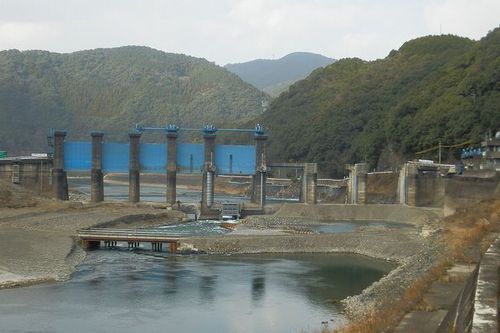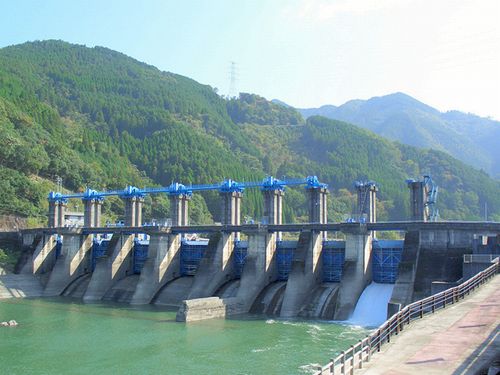November 28, 2014
Arase Dam: Japan's First Dam Removal Project Underway
Keywords: Ecosystems / Biodiversity Newsletter Water
JFS Newsletter No.147 (November 2014)

Arase Dam as of January 1, 2014
Photo by Norio Ogata Some Rights Reserved.
According to 2014 statistics released by the Japan Dam Foundation, as of March 31, 2013, there were 2,732 dams in Japan, including those under construction. Dams have been built mainly for flood control, household water resource reservation, industrial and agricultural water use, hydroelectric power generation and river environment management through stabilization of river flows.
While dams benefit us in daily life, adverse impacts of dam construction are becoming more of a source of controversy worldwide as a result of problems such as destruction of natural environments and local communities. Even after completion, dams have no small impact on the entire basin, surrounding ecosystems and people living in the watershed, because water retained by the dam deteriorates in quality and its temperature rises. This issue of the JFS Newsletter features the Arase Dam in Kumamoto Prefecture, the very first dam to be dismantled in Japan at the urging of local residents who have been suffering from the dam's impacts.
Overview of the Arase Dam
In the late 1940s, Kumamoto Prefecture suffered from power shortages because about 40 percent of the electricity generated within the prefecture was being sent to the Kitakyushu Industrial Zone in Fukuoka Prefecture. In response, Kumamoto Prefecture formulated the Kuma River Comprehensive Development Plan in 1951 to construct seven dams and 10 power plants along the Kuma River running through the southern part of the prefecture. This plan aimed to ensure a stable power supply by using the abundant water resources of the Kuma River, and as part of this plan the Arase Dam and Fujimoto Power Plant were built.
The Arase Dam, located at about 20 kilometers upstream from the river mouth, was built exclusively for hydroelectric power generation. From the intake on the right bank of the dam, water flows through a 600-meter tunnel to the turbines at a maximum rate of 134 cubic meters per second to generate electricity, using an effective head of 15.96 meters (vertical distance the water descends). The power plant began operation in December 1954 with a maximum output of 18,200 kilowatts. At the time of completion, the electricity generated accounted for about 16 percent of power demand within the prefecture.
Circumstances Leading to the Dam Removal
Before the water rights allocated to the prefecture expired in March 2003, Kumamoto Prefecture discussed their renewal, because the water rights were necessary for continued hydropower generation. Later, the prefecture decided to decommission and remove the Arase Dam because the local council had submitted an opinion brief that requested dam removal in response to local residents' complaints about adverse effects of the dam. Also, in view of the momentum of deregulation in the electricity sector, there was no guarantee of sustained future business with the dam. The water rights were extended until March 2010 in view of the time needed for dam removal.
How Did Residents' Voices Reach the Council?
Ever since the Arase Dam was built, the local residents in former Sakamoto Village (now the Sakamoto district of Yatsushiro City) have been aware of certain effects of the dam, such as vibrations and fewer sweetfish (or ayu in Japanese) in the river. Flood damage was especially severe. Even before the dam was completed, the area was affected by flooding. The dam's construction, however, caused large volumes of sludge to accumulate after floodwaters receded. Many residents moved out of the village, unable to cope with the repeated damage, and the population of the village, once nearly 20,000, plunged to less than one quarter of that.
Not only was the river basin impacted, but the dam also had negative effects on the ecosystem of an estuary in the Yatsushiro Sea, including reduced size of seaweed beds and tidal flats, which led to lower fish catches, sustaining fewer fishermen. As the deadline for renewal of water rights approached, the longing of the residents to be free from worries caused by the dam surfaced as a campaign for its decommissioning and removal.
On June 9, 2002, a river fishermen's union in former Sakamoto Village called for establishment of an association to reconsider the validity of the Arase Dam. This was the start of a full-scale campaign for decommissioning and removal. Many groups got involved in the campaign, increasing its influence, and an opinion brief arguing against retaining the dam was approved by the village council on September 20 of that year.
Responding to the campaign, Kumamoto Prefecture set up the Arase Dam Countermeasures Review Committee and a working group of experts in dam deconstruction, to study measures for minimizing impacts on the environment of the river basin during its removal. Reflecting their reviews, the prefectural government drew up an action plan for removal of the Arase Dam in March 2006, and discussed a scheme for removal based on that plan.
Kumamoto governor Ikuo Kabashima, however, announced in June 2008 that the prefecture would suspend the action plan for further review. The decision by Kabashima was influenced by newly revealed barriers such as estimated removal costs far exceeding expectations. Despite a basic understanding that perpetuating hydroelectricity generation by the Arase Dam was not the best choice and the dam should be removed once suitable conditions had been met, in November of that year the prefectural government decided to retain the Arase Dam in consideration of the prefecture's financial crisis.
Though this was a shocking disappointment to the residents longing for the dam's removal, they persevered, continuing their campaign for decommissioning and removal despite the prefectural decision to suspend the plan. Just then, the Ministry of Land, Infrastructure and Transport (MLIT) announced it had decided against continued renewal of the relevant water rights, previously extended until March 2010, and that Kumamoto Prefecture would need to apply again for water rights if it wished to continue generating hydroelectricity at the Arase Dam.
Kumamoto Prefecture finally decided to decommission and remove the Arase Dam in February 2010, stating, "Keeping the dam is no longer an appropriate option, as it would prolong confusion within the prefecture." The residents who had suffered from the negative impacts of the dam were finally rewarded for their long-continued efforts toward its removal.
Meanwhile, Kumamoto proclaimed it would make the Arase Dam an example for the nation of addressing actual removal of concrete dams. This would entail a number of challenges such as ensuring safety, establishing the necessary decommissioning and removal technologies, and minimizing environmental impacts. In April 2010, it created an R&D committee for technologies to remove Arase Dam and started formulating a removal plan for the deconstruction work.

Arase Dam before removal, November 2005
Photo by MK Products Some Rights Reserved.
Environmentally Conscious Dam Removal Work
The full-scale dismantling of the concrete Arase Dam is the first operation of its kind in Japan. The removal plan was crafted in consideration of economy and efficiency while avoiding adverse effects on river management, including flood control and environment issues. It also aimed to promote the medium-to-long-term recovery of the river's environment with the help of nature's regenerating power.
The scope of the dismantling work was chosen with a view to dealing with sediment accumulation and embankment erosion upstream and downstream of the dam. Possible options and methods were carefully selected in consideration of environmental impacts based on predictions of sediment outflow due to dam removal, including the height and composition of the riverbed and water levels in the reservoir and downstream river during and after the removal work.
A removal method was deemed optimal because of its effectiveness in restoring the river quickly to its original condition and its efficiency in application. Removal work is being conducted between mid-November and the end of February each year in consideration of the river's environment, which serves as habitat for sweetfish, one of the distinctive fish of the Kuma River.
Dam removal work was scheduled for six years starting from April 2012 to March 2018. In addition, environmental monitoring is scheduled for 10 consecutive years, including two years each before and after the operation. The atmosphere, noise, vibrations, water quality, sediment, flora, fauna, basic environment and scenery are being monitored in a reach of the river extending about 10 kilometers upstream and downstream of the dam, from the Setoishi Dam to the Yohaizeki Weir, that has been designated a model area for biodiversity conservation and restoration. Findings from other institutions will be utilized for the area downstream of Yohaizeki.
A specialist follow-up committee on the Arase Dam removal has been set up to carry out safe, environmentally conscious operations by evaluating and verifying the monitoring survey data. The committee holds meeting twice a year to accept reviews of their evaluations and the removal work from experts in various fields.
After the decision was made to remove the dam, its gates were opened on a regular basis. When the gates were fully opened in April 2010 after the water rights expired, the river gradually returned to its original condition and its water quality improved. By August that year, the river had improved to the point where local residents said it had regained 80 percent of its original condition.
This is the first time in Japan a dam has been dismantled against a backdrop of residents' protests. Effective utilization of the methods, procedures and monitoring data from this case is anticipated in future decisions involving other dams and rivers.
Written by Nobuhiro Tanabe
Related
"JFS Newsletter"
- 'Good Companies in Japan' (Article No.4): 'Eightfold Satisfaction' Management for Everyone's Happiness
- "Nai-Mono-Wa-Nai": Ama Town's Concept of Sufficiency and Message to the World
- 'Yumekaze' Wind Turbine Project Connects Metro Consumers and Regional Producers: Seikatsu Club Consumers' Co-operative
- Shaping Japan's Energy toward 2050 Participating in the Round Table for Studying Energy Situations
- 'Good Companies in Japan' (Article No.3): Seeking Ways to Develop Societal Contribution along with Core Businesses


